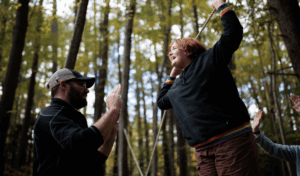 As the external sensations of our world continue to become more abundant and all consuming, we often overlook the sensations of our inner world. One of the most important and foundational sensory systems we have is our interoceptive system. Interoception is our body’s internal radar of the condition of our body, conveying information about the state of what is happening within the bounds of our skin.
As the external sensations of our world continue to become more abundant and all consuming, we often overlook the sensations of our inner world. One of the most important and foundational sensory systems we have is our interoceptive system. Interoception is our body’s internal radar of the condition of our body, conveying information about the state of what is happening within the bounds of our skin.
Our internal organs like our heart, lungs, intestines, bladder and even skin have receptors that send signals to our brain about the condition of those major organs. Interoception is our body’s ability to recognize and respond to those signals. For example, interoception includes awareness of changes in heart rate, blood pressure, body temperature, or sensations of pain, hunger, thirst, and other autonomic functions. Interoception also plays a significant role in emotional regulation, as emotions are a cascade of autonomic internal physiological responses that need our interpretation.
As with all things, when it comes to interoception, balance is key. People with limited interoception experience a disconnect between their mind and internal states, therefore they are often unaware of their emotional experiences and have challenges appropriately responding to the cues and signals their body is sending. A common situation most of us have probably had at some point is the phenomenon of being “hangry.” When this happens, we are disconnected from our bodies and missing the cues for hunger, resulting in irritability or dysregulation. On the other hand, some people are hyperaware of their internal sensations. To provide a similar example, this is when we have a hard time focusing on a meeting or class before lunch because all we can think about how our stomach is growling and feeling empty.
Whether you have limited or heightened interoceptive awareness, building a better relationship with your body’s internal cues is valuable for emotional wellness.
Limited Interoceptive Awareness
If you experience limited connection to your internal sensations and are often unaware of what is happening in your body, here a few ways to foster a stronger mind-body connection:
- A guided body scan meditation that cues you to focus on the sensations happening in specific parts of your body.
- Yoga, Tai Chi, or other movement practices that require you to be attuned to sensations such as breathing, heart rate, etc.
- Biofeedback is the process of conducting vitals or using a heart monitor to practice recognizing what different states of arousal feel like inside your body.
- Expand your vocabulary and practice using a variety of different language to describe your internal experiences. Communicating a visceral experience to yourself or others can be really challenging! Practice naming and describing sensations like their location, intensity, texture, size, color, etc.
Heightened Interoceptive Awareness
If you experience hyperawareness, and maybe even a little anxiety about your internal sensations, engage in interoceptive exposures to develop resilience to rebuild your relationship with those internal experiences. Examples of interoceptive exposures include:
Breathing: hold your breath for 30 seconds or breathe through a straw for 60 seconds.
Heart Rate: engage in intense exercise (burpees, running up and down stairs, jumping jacks) for 30 or 60 seconds.
Dizziness: shake your head side to side for 30 seconds or spin in a chair for 30 seconds.
Derealization: Stare at yourself in a mirror for 2 minutes or stair at a wall without blinking.
Temperature: Turn the cold water in the shower for 30 or 60 seconds or sit in a sauna/steam room for several minutes.
*These can be graded up or down according to your comfort level and can be increased as you build interoceptive tolerance.*
With each exposure, try to turn towards the internal sensations that you are having or practice diffusing the from the sensation (i.e. removing judgement and objectively observing and describing what is happening). As with all exposures, the most important part is to REFLECT on your experience. What happened? What did you learn? How does experience change how you might engage with your internal sensations moving forward?


